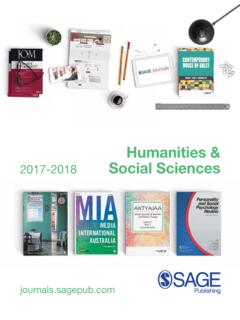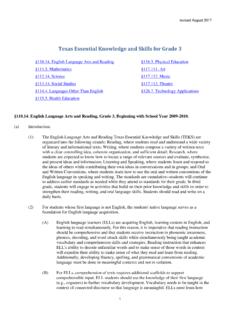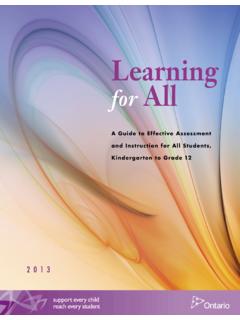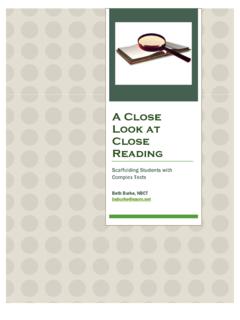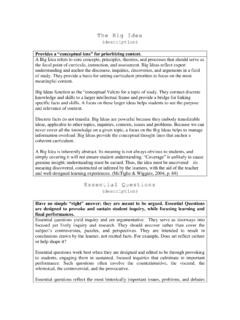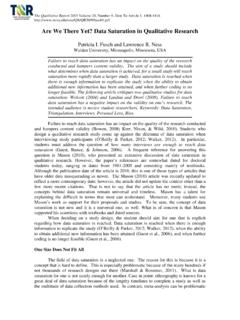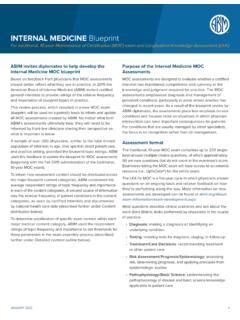Transcription of The Selection of a Research Approach - SAGE India
1 3 CHAPTER ONEThe Selection of a Research ApproachResearch approaches are plans and the procedures for Research that span the steps from broad assumptions to detailed methods of data collection, analysis, and interpretation. This plan involves several decisions, and they need not be taken in the order in which they make sense to me and the order of their presentation here. The overall decision involves which Approach should be used to study a topic. Informing this decision should be the philosophical assumptions the researcher brings to the study; procedures of inquiry (called Research designs); and specific Research methods of data collection, analysis, and interpretation.
2 The Selection of a Research Approach is also based on the nature of the Research problem or issue being addressed, the researchers personal experiences, and the audiences for the study. Thus, in this book, Research approaches, Research designs, and Research methods are three key terms that represent a perspective about Research that presents information in a successive way from broad con-structions of Research to the narrow procedures of THREE APPROACHES TO RESEARCHIn this book, three Research approaches are advanced: (a) qualitative, (b) quantitative, and (c) mixed methods.
3 Unquestionably, the three approaches are not as discrete as they first appear. Qualitative and quanti-tative approaches should not be viewed as rigid, distinct categories, polar opposites, or dichotomies. Instead, they represent different ends on a con-tinuum (Newman & Benz, 1998). A study tends to be more qualitative than quantitative or vice versa. Mixed methods Research resides in the middle of this continuum because it incorporates elements of both qualitative and quantitative ConsiderationsOften the distinction between qualitative Research and quantitative Research is framed in terms of using words (qualitative) rather than num-bers (quantitative), or using closed-ended questions (quantitative hypoth-eses) rather than open-ended questions (qualitative interview questions).
4 A more complete way to view the gradations of differences between them is in the basic philosophical assumptions researchers bring to the study, the types of Research strategies used in the Research ( , quantitative experi-ments or qualitative case studies), and the specific methods employed in conducting these strategies ( , collecting data quantitatively on instru-ments versus collecting qualitative data through observing a setting). Moreover, there is a historical evolution to both approaches with the quantitative approaches dominating the forms of Research in the social sciences from the late 19th century up until the mid-20th century.
5 During the latter half of the 20th century, interest in qualitative Research increased and along with it, the development of mixed methods Research . With this background, it should prove helpful to view definitions of these three key terms as used in this book: Qualitative Research is an Approach for exploring and understand-ing the meaning individuals or groups ascribe to a social or human problem. The process of Research involves emerging questions and pro-cedures, data typically collected in the participant s setting, data analysis inductively building from particulars to general themes , and the researcher making interpretations of the meaning of the data.
6 The final written report has a flexible structure. Those who engage in this form of inquiry support a way of looking at Research that honors an inductive style, a focus on individual meaning, and the importance of rendering the complexity of a situation. Quantitative Research is an Approach for testing objective theories by examining the relationship among variables. These variables, in turn, can be measured, typically on instruments, so that numbered data can be ana-lyzed using statistical procedures. The final written report has a set struc-ture consisting of introduction, literature and theory, methods, results, and discussion.
7 Like qualitative researchers, those who engage in this form of inquiry have assumptions about testing theories deductively, building in protections against bias, controlling for alternative explanations, and being able to generalize and replicate the findings. Mixed methods Research is an Approach to inquiry involving collecting both quantitative and qualitative data, integrating the two forms of data, and using distinct designs that may involve philosophical assumptions and theoretical frameworks. The core assumption of this form of inquiry is that the combination of qualitative and quantitative approaches provides a more complete understanding of a Research problem than either Approach alone.
8 The Selection of a Research Approach5 These definitions have considerable information in each one of them. Throughout this book, I discuss the parts of the definitions so that their meanings will become clear to you as you read COMPONENTS INVOLVED IN AN APPROACHTwo important components in each definition are that the Approach to Research involves philosophical assumptions as well as distinct methods or procedures. The broad Research Approach is the plan or proposal to conduct Research , involves the intersection of philosophy, Research designs, and spe-cific methods.
9 A framework that I use to explain the interaction of these three components is seen in Figure To reiterate, in planning a study, researchers need to think through the philosophical worldview assump-tions that they bring to the study, the Research design that is related to this worldview, and the specific methods or procedures of Research that trans-late the Approach into WorldviewsAlthough philosophical ideas remain largely hidden in Research (Slife & Williams, 1995), they still influence the practice of Research Philosophical WorldviewsDesigns Quantitative ( ,Experiments)Qualitative ( ,Ethnographies)Mixed Methods( ,Explanatory SequentialPostpositivistConstructivistTr ansformativePragmaticRESEARCH APPROACHESQ ualitativeQuantitativeMixed MethodsResearch MethodsQuestionsData CollectionData AnalysisInterpretationValidationFigure A Framework for Research The Interconnection of Worldviews, Design, and Research Methods 6 Preliminary Considerationsand need to be identified.)
10 I suggest that individuals preparing a Research proposal or plan make explicit the larger philosophical ideas they espouse. This information will help explain why they chose qualitative, quantitative, or mixed methods approaches for their Research . In writ-ing about worldviews, a proposal might include a section that addresses the following: The philosophical worldview proposed in the study A definition of basic ideas of that worldview How the worldview shaped their Approach to researchI have chosen to use the term worldview as meaning a basic set of beliefs that guide action (Guba, 1990, p.)

